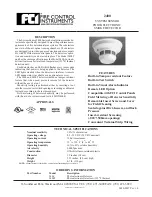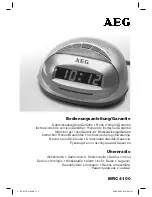
Fig. 1 a) – Single bedroom area
Fig. 1 b) – Multiple bedroom areas
Multi-Storey Dwellings
Install a smoke alarm on every floor of a multi-floor dwelling, as shown in
Fig. 2.
Fig. 2 – Multi-storey dwelling
Enhanced Safety
To improve early detection performance and safe evacuation, consider
installing additional smoke alarms as follows.
•
At least of two smoke alarms.
•
Inside every bedroom.
•
At both ends of a bedroom hallway if the hallway is more than 12 m.
•
Inside every room where one sleeps with the door partly or completely
closed, since smoke could be blocked by the closed door, and a hallway
alarm may not wake up the sleeper if the door is closed.
•
At the bottom of the basement stairwell.
•
Second-floor smoke alarms at the top of the first-to-second floor
stairwell.
•
In your living room, dining room, family room, attic, utility and storage
rooms.
Be sure no door or other obstruction blocks the smoke path to the smoke
alarm.
Installation Location
Install smoke & heat alarms as close to the centre of the ceiling as possible,
away from light fittings and air-conditioning ducts. If this is not practical, put the
alarm on the ceiling, no closer than 50 cm from any wall or corner as shown in
Fig. 3.
Fig. 3 – Smoke & heat alarm location
from walls
Under flat horizontal ceilings, the horizontal distance from any point in the
protected area to the detector nearest to that point should not exceed 5.3m for
heat detectors
If some of your rooms have sloped, peaked, or gabled ceilings, try to mount
alarms 0.9 m measured horizontally from the highest point of the ceiling.
Where Not to Install Your Smoke & heat alarm
Nuisance alarms occur when smoke & heat alarms are installed where they
will not work properly. To avoid nuisance alarms, do not install smoke & heat
alarms in the following situations.
•
In or near areas where combustion particles are present, such as
kitchens with few windows or poor ventilation, garages where there may
be vehicle exhaust, near furnaces, combustion heaters, and space
heaters. Combustion particles are the by-products of something that is
burning, which the smoke & heat alarm may detect.
•
Within 6 m of kitchens where combustion particles are normally present.
If a 6 m distance is not possible, e.g. in a mobile home, try to install the
smoke & heat alarm as far away from the combustion particles as
possible, preferably on the wall. Ensure the area is well ventilated.
•
In dead-air areas, where ventilation systems cause air-flow that would
not pass through the smoke & heat alarm sensing chamber. Avoid also
air-flow from areas where normal combustion particles are expected,
such as kitchens. Fig. 4, which indicates the correct and incorrect smoke
& heat alarm locations.
Fig. 4 – Dead-air areas
•
In damp or very humid areas, or within 3 m of bathrooms with showers.
Moisture in humid air can enter the sensing chamber, then condense into
droplets upon cooling, which can cause nuisance alarms.
•
In very cold or very hot areas, including unheated buildings or outdoor
rooms. If the temperature rises above or falls below the operating range
of smoke & heat alarm, it may not function properly. The temperature
range for your smoke & heat alarm is 0 °C ~ 45 °C.
•
In very dusty or dirty areas. Dirt and dust can build up on the smoke &
heat alarm’s sensing chamber, to make it overly sensitive. Additionally,
dust or dirt can block openings to the sensing chamber and limit the
smoke & heat alarm from sensing smoke.
•
Near fresh air vents or high draft areas like air conditioners, heaters or
fans, fresh air vents and drafts, which can drive smoke away from smoke
& heat alarms.
•
In dead air spaces, which are often at the top of a peaked roof or in apex
of ceilings and walls. Dead air may prevent smoke from reaching a
smoke & heat alarm. See Fig. 3 and 4 for recommended mounting
locations.
•
In insect-infested areas. If insects enter a smoke & heat alarm’s sensing
chamber, they may cause a nuisance alarm. Where insects are a
problem, get rid of them before installing the smoke & heat alarm.
•
Near fluorescent lights. Electrical “noise” from fluorescent lights may
cause nuisance alarms. Do not install smoke & heat alarms within 1.5 m
of such lights.
In the above locations, a heat alarm could be installed as additional protection.
Also the product shall not be contaminated by paint.
Installation and Test
Please read the previous section
Installation Preparation
, before
commencing installation.
Installing the Smoke & heat alarm Mains and Interconnection
Wiring
WARNING
: To avoid the electrical shock hazard, turn off power to the area
where you plan to install the alarm at the fuse box or circuit breaker box.
WARNING
: Connect the smoke & heat alarm to a continuous source of mains
power. Ensure the mains power cannot be inadvertently switched off.
It’s recommended that the supply and interconnection wiring to be installed in
accordance with BS 7671.
1.
Unhinged the smoke & heat alarm from the base by pressing the PUSH
button located on the side of the base part (see Fig. 5).
Fig. 5 – Press PUSH to unhinge base
2.
Place the bracket on the ceiling and mark drill hole locations through the
slots available in the base.
3.
Remove the smoke & heat alarm from the ceiling.
4.
Drill two 5 mm (3/16-inch) holes at the marks and insert the plastic
mounting plugs (supplied), or other mounting solution (depending on the
ceiling type).
5.
Run the mains wiring. Use wiring with conductors of 1 mm
2
~ 2.5 mm
2
cross-sectional area. Wiring should have an insulation resistance of at
least 300 V.
6.
Open the terminal cover to access the terminal screws and install the
wiring as shown in Fig. 6.
Key
L
AC 230 V mains live/active
E/LOOP Earth
or
loop
N
Neutral / interconnection common
I Interconnection
Fig. 6 – Mains wiring terminals and mounting slots
7.
Where interconnection to other ZT-MSH AC/DC smoke & heat alarms is
used, install the interconnection wiring as shown in Fig. 7.
WARNING
: Take care to ensure the insulation does not get clamped by
the terminal contact.
WARNING
: Do not connect this smoke and heat alarm to any device other
than another ZT-MS smoke alarm, ZT-MH heat alarm or ZT-MSH smoke and
heat alarm. Connecting anything else to this smoke and heat alarm may
prevent it from working properly.
WARNING
: To avoid the electrical shock hazard, do not use old wiring that
may have been used for mains voltages. Use wiring with conductors of 1 mm
2
~ 2.5 mm
2
cross-sectional area. Wiring should have an insulation resistance of
at least AC 300 V.
50cm min.






















